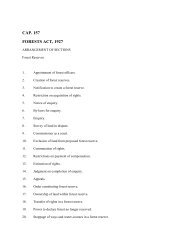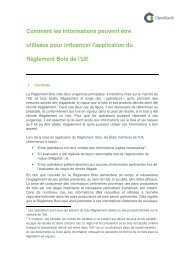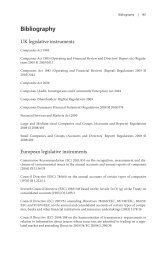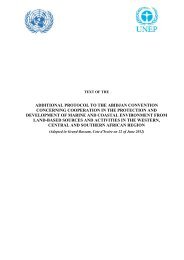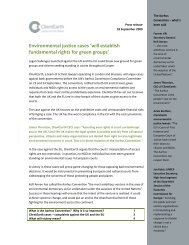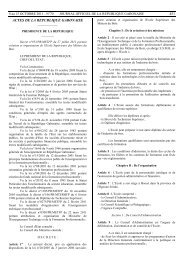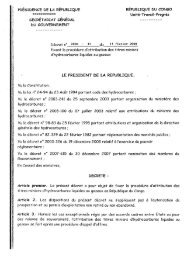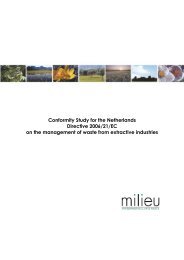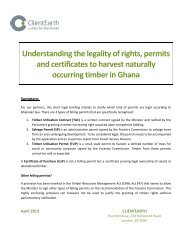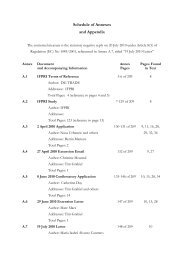Environmental and social transparency under the ... - ClientEarth
Environmental and social transparency under the ... - ClientEarth
Environmental and social transparency under the ... - ClientEarth
- No tags were found...
Create successful ePaper yourself
Turn your PDF publications into a flip-book with our unique Google optimized e-Paper software.
30 | <strong>Environmental</strong> <strong>and</strong> <strong>social</strong> <strong>transparency</strong> <strong>under</strong> <strong>the</strong> Companies Act 2006Chapter 1: Governance of company accounting <strong>and</strong> reporting | 31Detailed provisions have been made <strong>under</strong> <strong>the</strong> Large <strong>and</strong> Medium-sizedCompanies <strong>and</strong> Groups (Accounts <strong>and</strong> Reports) Regulations 2008 as tocertain matters that must be disclosed as part of <strong>the</strong> directors’ report. In<strong>the</strong>se detailed provisions, no environmental matters are covered. The<strong>social</strong> issues covered are primarily a restatement of those previouslyrequired by Schedule 7 of <strong>the</strong> Companies Act 1985, <strong>the</strong> very requirementsthat <strong>the</strong> Company Law Review process sought to <strong>and</strong> determined toimprove upon. This is not an adequately detailed regulatory framework.It is also important to note that even ‘unquoted’ companies, to which section417(5) does not apply, are required to report on some environmentalor <strong>social</strong> issues, where that information is necessary: for a fair review of<strong>the</strong> company’s business; 54 as part of a description of <strong>the</strong> principal risks<strong>and</strong> uncertainties facing <strong>the</strong> company; 55 as part of a balanced <strong>and</strong> comprehensiveanalysis of <strong>the</strong> development <strong>and</strong> performance of <strong>the</strong> company’sbusiness during <strong>the</strong> financial year, 56 <strong>and</strong> <strong>the</strong> position of <strong>the</strong> company’sbusiness at <strong>the</strong> end of that year. 57Section 417 of <strong>the</strong> Companies Act came into effect on 1 October 2007, 58<strong>and</strong> applies to all reporting years starting on or after that date. For reportsfor financial years before this date, <strong>the</strong> provisions of <strong>the</strong> Companies Act1985 applied.The directors’ report before <strong>the</strong> Companies Act 2006Under <strong>the</strong> Companies Act 1985, <strong>the</strong> legal requirements for <strong>the</strong> directors’report were considerably less extensive. The report only had to containa fair review of <strong>the</strong> development of <strong>the</strong> business of <strong>the</strong> company <strong>and</strong> itssubsidiaries during <strong>the</strong> year, its position at <strong>the</strong> end of it, 59 <strong>and</strong> <strong>the</strong> informationwhich was required by Schedule 7 of <strong>the</strong> Companies Act 1985. 60Schedule 7 set out a range of matters which <strong>the</strong> directors’ report had toinclude. 61 The requirements were considerably less dem<strong>and</strong>ing than <strong>the</strong>requirements of <strong>the</strong> Companies Act 2006, <strong>and</strong> it was considered by <strong>the</strong>Company Law Review that <strong>the</strong>y did not represent a coherent philosophy,<strong>and</strong> invited “st<strong>and</strong>ard <strong>and</strong> valueless statements”. 62To avoid <strong>the</strong> environmental <strong>and</strong> <strong>social</strong> reporting requirements of <strong>the</strong>Companies Act 2006 encouraging similarly ‘st<strong>and</strong>ard <strong>and</strong> valuelessstatements’, Regulations are needed to provide specificity <strong>and</strong> detail asto <strong>the</strong> precise scope of those requirements, complemented by robust <strong>and</strong>effective mechanisms to provide scrutiny to <strong>the</strong> process. This would representa considerable improvement on <strong>the</strong> 1985 Act in terms of ensuringthat broader contextual, non-financial information is included in annualreporting where appropriate.The ‘Operating <strong>and</strong> Financial Review’ (OFR) is also worth noting here(discussed in detail in Annex 2), as <strong>the</strong> predecessor to <strong>the</strong> directors’ reportof <strong>the</strong> Companies Act 2006. The OFR was initially a guidance frameworkdesigned to help directors effectively report on <strong>the</strong> main factors <strong>under</strong>lying<strong>the</strong> company’s performance <strong>and</strong> financial position, 63 including informationon non-financial factors. 64 In March 2005, a legal requirement forquoted companies to produce an OFR was introduced, 65 including explicitrequirements to report on environmental <strong>and</strong> <strong>social</strong> matters. However,just over half a year after enactment, it was announced that that statutoryobligation was to be abolished.The content requirements for environmental <strong>and</strong> <strong>social</strong> reporting whichhave been subsequently brought into law by <strong>the</strong> ‘business review’ requirementsof section 417 Companies Act 2006 are for <strong>the</strong> most part <strong>the</strong> sameas those of <strong>the</strong> OFR Regulations <strong>and</strong> Reporting St<strong>and</strong>ard. 66 The mainprevailing impact that <strong>the</strong> OFR’s removal has had in this area of law is on<strong>the</strong> st<strong>and</strong>ard of scrutiny that environmental <strong>and</strong> <strong>social</strong> reporting is subjectto from external audit. The cost to business of <strong>the</strong> OFR’s higher auditst<strong>and</strong>ard was <strong>the</strong> central justification for its removal. <strong>ClientEarth</strong> considersthat its proposals would not be in conflict with this policy decision,as it seeks to establish a regulatory framework that is cost-effective <strong>and</strong>‘light-touch’, scrutinising only those companies which are problematic,ra<strong>the</strong>r than imposing burden <strong>and</strong> expense on all companies regardless of<strong>the</strong> quality of <strong>the</strong>ir reporting practices.1.1.2 CoverageCompany operations <strong>and</strong> impacts are often very complex, especially in<strong>the</strong> multinational context, <strong>and</strong> especially in industries such as mining <strong>and</strong>o<strong>the</strong>r extractives. Companies will often have a variety of close economicrelationships with o<strong>the</strong>r legally distinct companies, making up structuresof merged interests, operations <strong>and</strong> control. These relationships, <strong>and</strong> <strong>the</strong>environmental <strong>and</strong> <strong>social</strong> impacts of such related companies, are extremelyrelevant to a company’s business performance.



